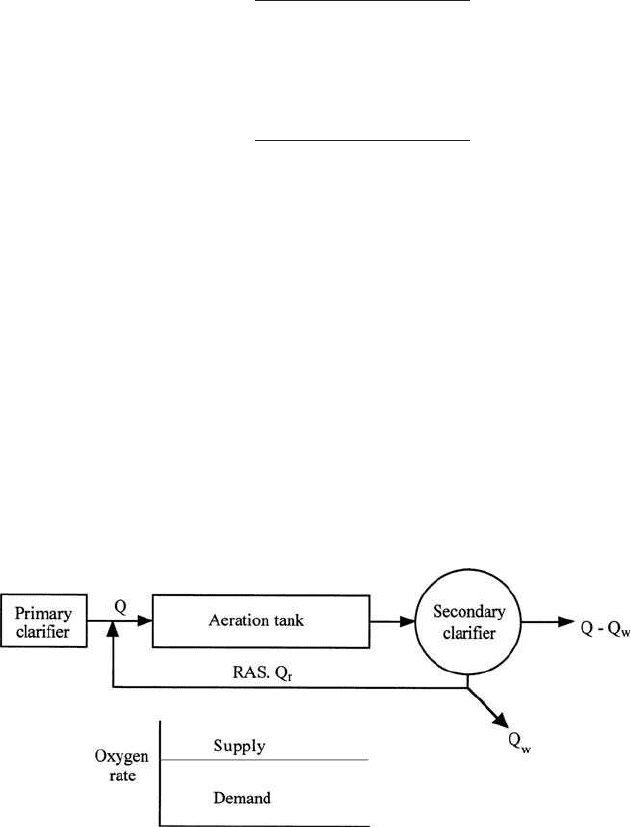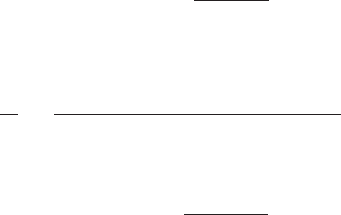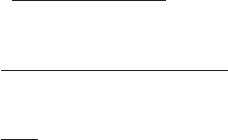Lin S.D. Water and Wastewater Calculations Manual
Подождите немного. Документ загружается.


Step 6. Check the surface overflow rate at average design flow
Note: This is less than the design criteria of 15 m
3
/(m
2
⭈ d)
Step 7. Check the clarifier’s area for clarification requirements
From Step 6, the calculated surface overflow rate
Q/A ⫽ 10.4 m
3
/(m
2
⭈ d) ⫽ 0.433 m/h
From Fig. 6.16, the MLSS concentration corresponding to a 0.433 m/h of
settling rate is 4700 mg/L. The design MLSS is only 2400 mg/L. The area is
sufficient.
Step 8. Check the surface overflow rate at peak design flow
Step 9. Determine recycle ratio required to maintain MLSS concentra-
tion at 3000 mg/L
(Q ⫹ Q
r
) ⫻ 3000 ⫽ QX ⫹ Q
r
X
u
where Q ⫽ influent flow, m
3
/d or Mgal/d
Q
r
⫽ recycle flow, m
3
/d or Mgal/d
X ⫽ influent SS concentration, mg/L
X
u
⫽ underflow SS concentration, mg/L
Q
r
Q
5
3000 2 X
X
u
2 3000
5 a 5 recycle ratio
Qs3000 2 X d 5 Q
r
sX
u
2 3000d
5 21.2 m
3
/sm
2
#
dd
Overflow rate 5
82,062 m
3
/d
1942 m
2
3 2
5 82,232 m
3
/d
Peak flow 5 0.80 m
3
/s 3 86,400 s/d 1 13,112 m
3
/d
5 255 gal/sd
#
ft
2
d
5 10.4 m
3
/sm
2
#
dd
Overflow rate 5
Q
A
5
20,200 m
3
/d
1942 m
2
5 164 ft
5 49.7 m < 50 m
d 5 21942 m
2
3 4 4 3.14
Wastewater Engineering 645

when X
u
⫽ 9300 mg/L (from Step 3) and
Step 10. Estimate the depth required for the thickening zone
The total depth of the secondary clarifier is the sum of the required depths
of the clear water zone, the solids thickening zone, and the sludge storage
zone. In order to estimate the depth of the thickening zone, it is assumed that,
under normal conditions, the mass of solids retained in the secondary clari-
fier is 30% of the mass of solids in the aeration basin, and that the average
concentration of solids in the sludge zone is 7000 mg/L (Metcalf and Eddy, Inc.
1991). The system has 4 aeration tanks and 2 clarifiers.
(a) Compute total mass of solids in each aeration basin
MLSS ⫽ 3000 mg/L ⫽ 3.0 kg/m
3
Refer to Step 7 of Example 1a
Solids in each aeration tank ⫽ 3.0 kg/m
3
⫻ 4.4 m ⫻ 12.6 m ⫻ 25.2 m
⫽ 4191 kg
(b) Compute the mass of solids in a clarifier for 2 days (see Step 11)
Solids in each clarifier ⫽ 4191 kg ⫻ 0.3 ⫻ 2
⫽ 2515 kg
(c) Compute depth of sludge zone
Step 11. Estimate the depth of the sludge storage zone
This zone is provided to store excess solids at peak flow conditions or at a
period over which the sludge-processing facilities are unable to handle the
sludge quantity. Assume storage capacity for 2 days’ sustained peak flow (of
2.5 average flow) and for 7 days’ sustained peak BOD loading (of 1.5 BOD
average).
< 0.2 m
5 0.19 m
Depth 5
mass
area 3 concentration
5
2515 kg 3 1000 g/kg
1942 m
2
3 7000 g/m
3
5 0.46
a 5
3000 mg/L 2 93 mg/L
9300 mg/L 2 3000 mg/L
X 5 93 mg/L sfrom Step 3 of Example 1a, 92.8 mg/Ld
646 Chapter 6

(a) Calculate total volatile solids generated under sustained BOD loading.
Using Eq. (6.91)
P
x
⫽ Y
obs
Q(S
0
⫺ S ) ⫼ (1000 g/kg)
Y
obs
⫽ 0.3125 (from Step 9(a) of Example 1a)
Q ⫽ 2.5 (0.32 m
3
/s) ⫽ 0.8 m
3
/s ⫽ 69,120 m
3
/d
S
0
⫽ 161.5 mg/L ⫻ 1.5 ⫽ 242 mg/L
S ⫽ 5.7 mg/L ⫻ 1.5 ⫽ 9 mg/L
P
x
⫽ 0.3125 ⫻ 69,120 m
3
/d ⫻ (242 ⫺ 9) g/m
3
⫼ (1000 g/kg)
⫽ 5033 kg/d
(b) Calculate mass of solid for 2-day storage
Total solids stored ⫽ 5033 kg/d ⫻ 2 d ⫼ 0.8
⫽ 12,580 kg
(c) Calculate stored solids per clarifier
Solids to be stored ⫽ 12,580 kg ⫼ 2
⫽ 6290 kg
(d) Calculate total solids in each secondary clarifier
Total ⫽ 6290 kg ⫹ 2515 kg (from Step 10b)
⫽ 8805 kg
(e) Calculate the required depth for sludge storage in the clarifier
Step 12. Calculate total required depth of a clarifier
The depth of clear water and settling zone is commonly 1.5 to 2 m. Provide
2 m for this example.
Total required depth of a clarifier ⫽ 2 m ⫹ 0.2 m ⫹ 0.63 m
⫽ 2.83 m
< 3 m
With addition of 0.65 m freeboard,
the total water depth of the clarifier ⫽ 3.65 m
⫽ 12 ft
5 0.63 m
Depth 5
8505 kg 3 1000 g/kg
7000 g/m
3
3 1942 m
2
Wastewater Engineering 647

648 Chapter 6
Step 13. Check hydraulic retention time of the secondary clarifier
Diameter ⫽ 50 m (from Step 5)
Volume ⫽ 3.14 (50 m/2)
2
⫻ 3.0 m
⫽ 5888 m
3
Under average design flow plus recirculation, from Step 4
⫽ 3.5 h
At peak design flow with recirculation, from Step 8
⫽ 1.72 h
Plug-flow with recycle.
Conventional and many modified activated-
sludge processes are designed approximately like the plug-flow model
(Fig. 6.18). In a time plug-flow reactor, all fluid particles entering the
reactor stay in the reactor for an equal amount of time and pass through
the reactor in sequence. Those that enter first leave first. It is assumed
that there is no mixing in the lateral direction. In practice, a time plug-
flow reactor is difficult to obtain because of longitudinal dispersion. In
a real plug-flow, some particles may make more passes through the
reactor as a result of recycling.
The mathematical modeling for the plug-flow process is difficult. The
most accepted useful kinetic model of the plug-flow reactor for the activated-
sludge process was developed by Lawrence and McCarty (1969). They
HRT 5
5888 m
3
3 24 h/d
82,062 m
3
/d sfrom Step 8d
HRT 5
5888 m
3
3 24 h/d
40,400 m
3
/d sfrom Step 4d
Figure 6.18 Conventional activated-sludge process and DO in aeration tank.

Wastewater Engineering 649
made two assumptions: (1) The concentration of microorganisms in the
influent of the reactor is approximately the same as that in the effluent
of the reactor. This assumption is valid only when
c
/ ⬎5. (2) The rate
of substrate utilization r
su
as wastewater flows through the aeration
tank is expressed as
(6.99)
The reverse of the mean cell residence time is
(6.100)
and
(6.101)
where r
su
⫽ substrate utilization rate, mg/L
S ⫽ effluent concentration of substrate, mg/L
S
0
⫽ influent concentration of substrate, mg/L
X ⫽ average concentration of microorganisms in the
reactor, mg/L
k, K
s
, Y ⫽ kinetic coefficients as defined previously
u
c
⫽ mean cell residence time, day
a ⫽ recycle ratio
S
i
⫽ influent concentration in reactor after dilution with
recycle flow
21.6 Operation and control of
activated-sludge processes
The aeration basin is the heart of the activated-sludge process. Process
operation and system controls usually need well trained operators, with
operational parameters such as air or oxygen supply, F/M ratio, and
mass balance to return activated sludge. However, some nontheoretical
indexes such as sludge volume index, sludge density index, sludge set-
tleability, and sludge age are widely used and valuable tools for the
daily process of operation and control.
Sludge volume index. The sludge volume index (SVI) is the volume of mL
occupied by 1 g of suspension after 30 min of settling. Although SVI is not
theoretically supported, experience has shown it is useful in routine process
control. SVI typically is used to monitor the settling characteristics of acti-
vated sludge and can impact on return sludge rate and MLSS.
S
i
5
S
0
1 aS
1 1 a
1
u
c
5
YksS
0
2 Sd
sS
0
2 Sd 1 s1 1 adK
s
lnsS
i
/Sd
2 k
d
r
su
5
kSX
K
s
1 S

SVI is calculated from the laboratory test results of the suspended
solids concentration of a well mixed sample of the suspension and the
30-min settled sludge volume. The sludge volume is measured by fill-
ing a 1-liter graduated cylinder to the 1.0-liter mark, allowing settling
for 30 min, and then reading the volume of settled solids. The mixed
liquid suspended solids is determined by filtering, drying, and weigh-
ing a sample of the mixed liquor as stated in the previous section in this
chapter. The value of SVI can be calculated by the following formula
(Standard Methods—APHA et al., 1998).
(6.102)
or
(6.102a)
where SVI ⫽ sludge volume index, mL/g
SV ⫽ settled sludge volume, mL/L
MLSS ⫽ mixed liquor suspended solids, mg/L
1000 ⫽ milligrams per gram, mg/g
Typical values of SVI for domestic activated-sludge plants operating
with an MLSS concentration of 2000 to 3500 mg/L range from 80 to 150
mL/g (Davis and Cornwell, 1991).
The SVI is an important factor in process design. It limits the tank
MLSS concentration and return sludge rate.
Sludge density index. Sludge density index is used in a way similar to
the sludge volume index to indicate the settleability of a sludge in a sec-
ondary clarifier or effluent. The weight in grams of 1 mL of sludge, after
settling for 30 min, is calculated as
SDI ⫽ 100/SVI (6.103)
where SDI ⫽ sludge density index, g/mL
SVI ⫽ sludge volume index, mL/g
A sludge with good settling characteristics has an SDI of between 1.0
and 2.0, whereas an SDI of 0.5 indicates a bulky or nonsettleable sludge
(Cheremisinoff, 1995).
Return activated sludge. Return activated sludge is the settled acti-
vated sludge that is collected in the secondary clarifier and returned to
the aeration tank to mix with the influent wastewater.
SVI 5
Wet settled sludge, mL/L
Dry sludge solid, mg/L
SVI 5
SV 3 1000 mg/g
MLSS
650 Chapter 6

The efficiency of the activated-sludge process is measured by BOD
removal, which is directly related to the volatile activated-sludge solids
in the aeration basin. The purpose of sludge return is to maintain a suf-
ficient concentration of activated sludge in the aeration tank. The RAS
makes it possible for the microorganisms to be in the treatment system
longer than the flowing wastewater. The RAS flow for a conventional
activated-sludge system is usually 20% to 40% of the tank influent flow
rate. Table 6.13 lists typical ranges of RAS flow rates for some of the acti-
vated-sludge processes. Sludge volume index (Eq. (6.102)) is empirical and
is used to control the rate of return sludge. The minimum percentage of
return activated sludge is related to SVI and the solids concentration in
the mixed liquor and is expressed as (Clark and Viessman, 1966)
(6.104)
where SVI ⫽ sludge volume index, mL/g
P ⫽ percentage of solids in the mixed liquor
Example 1: Determine the aeration basin dimensions for a town of 20,000 pop-
ulation. Assume the mixed liquor suspended solids is 2600 mg/L; BOD loading
rate is 0.48 kg/(d ⭈ m
3
) or 0.03 lb/(d ⭈ ft
3
); SVI ⫽ 110 mL/g; and P ⫽ 2600 mg/L.
solution:
Step 1. Calculate total BOD loading (L) on aeration basin
Using average BOD contribution of 0.091 kg/(person ⭈ d) or 0.20 lb/(c ⭈ d)
Total BOD load to the wastewater
treatment plant ⫽ 20,000 person ⫻ 0.091 kg/(person ⭈ d)
⫽ 1820 kg/d
% of return sludge 5
100
100/sSVIdP 2 1
TABLE 6.13 Guidelines for Return Activated Sludge Flow Rate
Percent of design average flow
Type of process Minimum Maximum
Conventional 15 100
Carbonaceous stage of 15 100
separate-stage nitrification
Step-feed aeration 15 100
Complete-mix 15 100
Contact stabilization 50 150
Extended aeration 50 150
Nitrification stage of 50 200
separate stage nitrification
SOURCE: GLUMRB (Ten States Standards) (1996)
Wastewater Engineering 651

652 Chapter 6
Assume 30% BOD removal in the primary clarifiers.
The total daily BOD load on aeration basin would be
L ⫽ 1820 kg/d ⫻ (1.0 – 0.3) ⫽ 1274 kg/d
Step 2. Calculate percentage return activated sludge
Using Eq. (6.104)
SVI ⫽ 110 mL/g
P ⫽ 2600 mg/L ⫽ 0.26%
⫽ 40
Step 3. Determine the total BOD loading on the basin
Assume the BOD concentration for both the RAS and the influent are the
same.
Allowing an additional 40% of return sludge, the total BOD loading
would be
1274 kg/d ⫻ 1.40 ⫽ 1784 kg/d
Step 4. Determine the volume V required for the aeration tank
⫽ 3717 m
3
Step 5. Determine the dimensions of the aeration tank
Select eight tanks, the water depth of 4.4 m, and add 0.6 m for the freeboard,
and width of 7 m. The length of a tank is
⫽ 15 m
Note: Each tank measures 5 m ⫻ 7 m ⫻ 15 m.
Example 2: Determine the aeration tank based on 6 h of aeration period,
using the data given in Example 1. Assume 0.53 m
3
/(person ⭈ d) or 140
gal/(c ⭈ d) of waste flow.
length 5
3717 m
3
8 3 4.4 m 3 7 m
5
1784 kg/d
0.48 kg/sd
#
m
3
d
V 5
Total BOD loading
Allowed loading per m
3
% return 5
100
100/sSVIdP 2 1
5
100
100/s100 3 0.26d 2 1

Wastewater Engineering 653
solution:
Step 1. Calculate plant flow rate Q
Q ⫽ 0.53 m
3
/(person ⭈ d) ⫻ 20,000 persons
⫽ 10,600 m
3
/d
Step 2. Plus 40% of Q
r
Q ⫹ Q
r
⫽ 1.4 ⫻ 10,600 m
3
/d
⫽ 14,840 m
3
/d
Step 3. Calculate the required volume V of a tank
V ⫽ 14,840 m
3
/d ⫻ (1 day/24 h) ⫻ 6 h
⫽ 3710 m
3
Note: For these two examples, the tank volume determined is based on either
organic loading or hydraulic loading; these give almost identical results.
Step 4. Determine tank dimensions
Use eight tanks with depth of 5 m, width of 7 m, and length of 15 m, as in
Example 1.
Return activated-sludge flow rate. The RAS, at a constant flow rate, is
independent of the tank influent flow rate and changes the MLSS in the
tank continuously. The MLSS concentration will be at a maximum
during low influent flows and at a minimum during peak influent flows.
The secondary clarifier must constantly change the depth of the sludge
blanket. To maintain a good F/M ratio, a programmed control device
should be installed to maintain a constant percent of RAS flow to the
tank influent flow. However, any change in the activated-sludge qual-
ity will require a different RAS flow rate because of the changing set-
tling characteristics of the sludge.
The relationship between maximum RAS concentration (X
r
) and SVI can
be derived from Eq. (6.69) using settled sludge volume SV ⫽ 1000 mL/L.
The suspended solids concentration in RAS can be calculated by
(6.105)
X
r
5
10
6
SVI
mg/L
5
1000 mL/L 3 1000 mg/g
SVI mL/g
X
r
5 a
SV 3 1000 mg/g
SVI
b

654 Chapter 6
Sludge settleability. Another method of calculating RAS flow rate is
based on the settleability approach. The settleability is defined as the
percentage of volume occupied by the sludge after settling for 30 min.
The RAS flow rate is related to settled sludge volume as follows:
1000Q
r
⫽ (SV)(Q ⫹ Q
r
) (6.106)
or
(6.107)
where 1000 ⫽ factor mg/L
Q
r
⫽ flow of return activated sludge, m
3
/s or Mgal/d
Q ⫽ flow of tank influent, m
3
/s or Mgal/d
SV ⫽ settled sludge volume (30-min settling), mL/L
Example: In practice, the operator checks the VSS concentration in the return
activated sludge at least once every shift and makes the appropriate RAS flow
rate adjustment. The previous operator recorded that RAS flow was 44 gal/min
(240 m
3
/d) with the VSS in RAS of 5800 mg/L. The on-duty operator determines
the VSS in RAS as 5500 mg/L. What should the RAS flow rate be adjusted to?
solution: Since the VSS in the RAS is decreasing, the sludge wasting flow
should be increased proportionally to waste the amount of VSS.
Q
adj
⫻ 5550 mg/L ⫽ 44 gal/min ⫻ 5800 mg/L
Q
adj
⫽ 44 ⫻ 5800/5550 gal/min
⫽ 46 gal/min
⫽ 250 m
3
/d
Aeration tank mass balance.
In practice, the maximum RAS pumping
capacity is commonly designed as 100% of design average flow (use 150%
for oxidation ditch). The required RAS pumpage can be determined by aer-
ation tank mass balance. Assume new cell growth is negligible and there
is no accumulation in the aeration tank. Also, the solids concentration in
the tank influent is negligible compared to the MLSS, X, in the tank. Thus
mass of inflow is equal to that of outflow. This can be expressed as
X
r
Q
r
⫽ X(Q ⫹ Q
r
) (6.108)
or
(6.109)
(6.110)
X
r
5
XsQ 1 Q
r
d
Q
r
5
MLSSsQ 1 Q
r
d
Q
r
Q
r
5
X
X
r
2 X
Q
Q
r
5
sSVdQ
1000 2 SV
